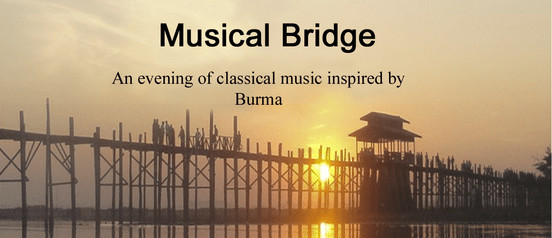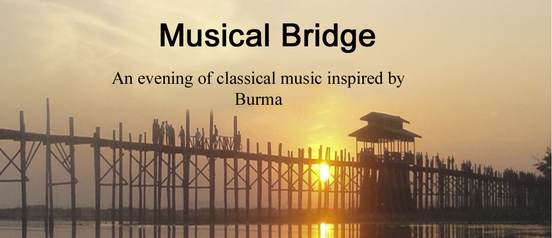I recently heard about an very interesting musical event – a concert in aid of Link Emergency Aid & Development of Burma, which brings young Western composers and classical musicians together to play traditional music, and music inspired by Burma.
Burma (officially now called Myanmar) is a country of about 50 million people, bordering China to the North and Thailand to the East. It has an ancient musical tradition, which in recent years has been adapted to accommodate first Western classical music, then rock, and most recently hip-hop and rap.
The concert, “Musical Bridge”, is the brainchild of Zaw Lu Aung, a Londoner who was born and raised in Burma and has been speaking and writing on Burmese issues for several years. I won’t attempt to address the political and social situation in Burma here – but please follow some of the links at the bottom of this post to read more about it, and learn how some young people in Burma are speaking out through music.
A brief audio glimpse
I was intrigued by the concert’s concept, and not knowing much about the music of Myanmar, I set out to explore – with Spotify as my atlas. If you’re in the U.K. or other Spotify-friendly country, you can click here to listen to the playlist I created:
 A brief glimpse of the music of Burma
A brief glimpse of the music of Burma
No doubt this is far from a representative cross-section of traditional Burmese music! But for an instant access quick impression, Spotify’s a handy service to have around!
Here’s a brief overview of what I heard in a few hours of listening:
I’m not particularly well versed in Eastern music, but to my ears it seems that Burmese music shares some aspects with Indian, Chinese, and Japanese music, while having a very particular character of its own. As I listened, here are some of the things which began to emerge:
- Vocals – Some similar scales and runs to Indian musical traditions
- Orchestration – Wonderful plucked strings, bells, some wind instruments
- Arrangements – Markedly different from other genres and countries. Often several instruments will play the same melody – but each loosely rather than all in lock-step as would happen in unison arrangements in Western music.
- Rhythm – Really interesting juxtapositions of different rhythms. Some great driving rhythms, with a touch Celtic reel about them at times!
Once I tuned my ear in, I adored the blend of styles – often the composition, arrangement, or performance seemed familiar in ways (from other world musics), but now combined in a way which plays to the strengths of each. I would strongly encourage you to listen for yourself – whether on Spotify, YouTube, Last.FM, on the web or by buying CDs or MP3s.
My observations are from the point of view of a novice, so if you’re reading this as an expert: please forgive my ignorance! But that’s a quick sketch of what my ears encountered as I listened. If you follow my advice and listen for yourself, I’d love to hear your thoughts – whether you’re an expert, or new to the music like me.
Musical Bridge
The concert, this Saturday (15th May) in London promises a selection of traditional Burmese music, traditional Western music, and some new compositions of Burmese music re-interpreted by young Western composers. Tickets are still available, through the organisers – send an email or call them on 07780 995249.
If you find yourself in London, I would highly recommend giving your ears a novel treat by attending – I’ll certainly be there! Otherwise, you should definitely take the time to explore the music of Burma online – I guarantee you’ll find something wonderful and distinctive which will stretch your ears in a new direction.
More information on the concert.
Read about Myo-ma Nyein, who pioneered the new era of classical music in Burma.
Read about the Burmese musicians writing protest songs after choosing exile over censorship
Read about the Hip-Hop resistance in Burma and Generation Wave, the underground label publishing protest songs.









